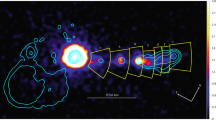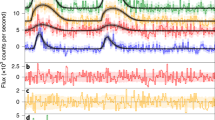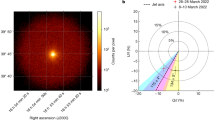Abstract
Gamma-ray emission from blazars is known to originate from jets emitted by supermassive black holes1. However, the exact location and size of the γ-ray emitting part of the jets is uncertain2,3,4,5,6. The main difficulty is the very small angular size of these sources, beyond the angular resolution of γ-ray telescopes. Here, we report a measurement of the projected size of the γ-ray jet, revealed by the detection of microlensing in the gravitationally lensed blazar PKS 1830-211. This measurement is consistent with a constraint from the intrinsic variability timescale of the blazar. Our measurement shows that the γ-ray emission originates from the vicinity of the central supermassive black hole. Combining the X-ray and γ-ray data, we use the microlensing effect to constrain the size of the X-ray source. We show that the effect of pair production of γ-rays on X-ray photons does not make the source opaque, owing to the large size of the X-ray emission region.
This is a preview of subscription content, access via your institution
Access options
Subscribe to this journal
Receive 12 print issues and online access
$259.00 per year
only $21.58 per issue
Buy this article
- Purchase on SpringerLink
- Instant access to full article PDF
Prices may be subject to local taxes which are calculated during checkout


Similar content being viewed by others
References
Urry, C. M. & Padovani, P. Unified schemes for radio-loud active galactic nuclei. Publ. Astron. Soc. Pac. 107, 803–845 (1995).
Aharonian, F. et al. An exceptional very high energy γ-ray flare of PKS 2155-304. Astrophys. J. 664, L71–L74 (2007).
Vovk, I. & Neronov, A. Variability of γ-ray emission from blazars on black hole timescales. Astrophys. J. 767, 103 (2013).
Abdo, A. A. et al. A change in the optical polarization associated with a γ-ray flare in the blazar 3C279. Nature 463, 919–923 (2010).
Tavecchio, F. et al. On the origin of the γ-ray emission from the flaring blazar PKS 1222+216. Astron. Astrophys. 534, A86 (2011).
Ghisellini, G., Tavecchio, F., Foschini, L., Bonnoli, G. & Tagliaferri, G. The red blazar PMN J2345-1555 becomes blue. Mon. Not. R. Astron. Soc. 432, L66 (2013).
Nolan, P. L. et al. Fermi large area telescope second source catalog. Astrophys. J. 199, 31 (2012).
Jelley, J. V. Absorption of high-energy γ-rays within quasars and other radio sources. Nature 211, 472–475 (1966).
Maraschi, L., Ghisellini, G. & Celotti, A. A jet model for the γ-ray emitting blazar 3C 279. Astrophys. J. 397, L5–L9 (1992).
Dermer, C. D., Schlickeiser, R. & Mastichiadis, A. High-energy γ radiation from extragalactic radio sources. Astrophys. J. 256, L27–L30 (1992).
Bednarek, W. Can high-energy γ-ray photons escape from the radiation field emitted by an accretion disk? Astron. Astrophys. 278, 307–314 (1993).
Liu, H. T. & Bai, J. M. Absorption of 10–200 GeV γ rays by radiation from broad-line regions in blazars. Astrophys. J. 653, 1089–1097 (2006).
Poutanen, J. & Stern, B. GeV Breaks in blazars as a result of γ-ray absorption within the broad-line region. Astrophys. J. 717, L118–L121 (2010).
Begelman, M. C., Fabian, A. C. & Rees, M. J. Implications of very rapid TeV variability in blazars. Mon. Not. R. Astron. Soc. 384, L19–L23 (2008).
Giannios, D., Uzdensky, D. A. & Begelman, M. C. Fast TeV variability in blazars: Jets in a jet. Mon. Not. R. Astron. Soc. 395, L29–L33 (2009).
Barkov, M. V., Aharonian, F. A., Bogovalov, S. V., Kelner, S. R. & Khangulyan, D. Rapid TeV variability in blazars as a result of jet–star interaction. Astrophys. J. 749, 119 (2012).
Mediavilla, E., Jimenez-Vicente, J., Munoz, J. A., Mediavilla, T. & Ariza, O. Statistics of microlensing caustic crossings in Q 2237+0305: Peculiar velocity of the lens galaxy and accretion disk size. Astrophys. J. 798, 138 (2015).
Guerras, E. et al. Microlensing of quasar ultraviolet iron emission. Astrophys. J. 778, 123 (2013).
Kochanek, C. S. Quantitative interpretation of quasar microlensing light curves. Astrophys. J. 605, 58–77 (2004).
Eigenbrod, A. et al. Microlensing variability in the gravitationally lensed quasar QSO 2237+0305 = the Einstein Cross. II. Energy profile of the accretion disk. Astron. Astrophys. 490, 933–943 (2008).
Chartas, G. et al. Revealing the structure of an accretion disk through energy-dependent X-ray microlensing. Astrophys. J. 757, 137 (2012).
Jauncey, D. L. et al. An unusually strong Einstein ring in the radio source PKS1830-211. Nature 352, 132–134 (1991).
Lidman, C. et al. The redshift of the gravitationally lensed radio source PKS 1830-211. Astrophys. J. 514, L57–L60 (1999).
Wiklind, T. & Combes, F. The redshift of the gravitational lens of PKS1830-211 determined from molecular absorption lines. Nature 379, 139–141 (1996).
Lovell, J. E. J. et al. PKS 1830-211: A possible compound gravitational lens. Astrophys. J. 472, L5–L7 (1996).
Cheung, C. C. et al. Fermi Large Area Telescope detection of gravitational lens delayed?—Ray flares from blazar B0218+357. Astrophys. J. 782, L14 (2014).
Abdo, A. A. et al. γ-ray flaring activity from the gravitationally lensed blazar PKS 1830–211 observed by Fermi LAT. Astrophys. J. 799, 143 (2015).
Lovell, J. E. J. et al. The time delay in the gravitational lens PKS 1830-211. Astrophys. J. 508, L51–L54 (1998).
Chang, K. Maximum flux amplification by star disturbances in gravitational lens galaxies. Astron. Astrophys. 130, 157–161 (1984).
Kogut, A. et al. Dipole anisotropy in the COBE differential microwave radiometers first-year sky maps. Astrophys. J. 419, 1–6 (1993).
Acknowledgements
The work of I.V. is supported by the Swiss National Science Foundation grant P2GEP2_151815. The work of A.N. is supported by the Swiss National Science Foundation grant PP00P2_144923.
Author information
Authors and Affiliations
Contributions
I.V. and D.M. performed the analysis of the Fermi/LAT data. A.N. and I.V. jointly investigated the theoretical aspects of this work. D.M. performed the analysis of the INTERGRAL observations. A.N. and I.V. jointly wrote the paper. All authors took part in discussion of the results and contributed to the manuscript.
Corresponding authors
Ethics declarations
Competing interests
The authors declare no competing financial interests.
Supplementary information
Supplementary Information
Supplementary Information (PDF 2097 kb)
Rights and permissions
About this article
Cite this article
Neronov, A., Vovk, I. & Malyshev, D. Central engine of a gamma-ray blazar resolved through the magnifying glass of gravitational microlensing. Nature Phys 11, 664–667 (2015). https://doi.org/10.1038/nphys3376
Received:
Accepted:
Published:
Issue date:
DOI: https://doi.org/10.1038/nphys3376
This article is cited by
-
The extragalactic gamma-ray sky in the Fermi era
The Astronomy and Astrophysics Review (2016)



